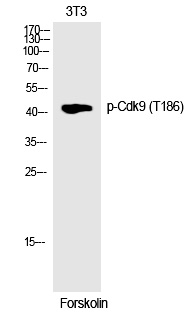
| WB | 咨询技术 | Human,Mouse,Rat |
| IF | 咨询技术 | Human,Mouse,Rat |
| IHC | 咨询技术 | Human,Mouse,Rat |
| ICC | 技术咨询 | Human,Mouse,Rat |
| FCM | 咨询技术 | Human,Mouse,Rat |
| Elisa | 1/5000 | Human,Mouse,Rat |
| Aliases | CDK9; CDC2L4; TAK; Cyclin-dependent kinase 9; C-2K; Cell division cycle 2-like protein kinase 4; Cell division protein kinase 9; Serine/threonine-protein kinase PITALRE; Tat-associated kinase complex catalytic subunit |
| Entrez GeneID | 1025; |
| WB Predicted band size | 42kDa |
| Host/Isotype | Rabbit IgG |
| Antibody Type | Primary antibody |
| Storage | Store at 4°C short term. Aliquot and store at -20°C long term. Avoid freeze/thaw cycles. |
| Species Reactivity | Human,Mouse,Rat |
| Immunogen | Synthesized peptide derived from human Cdk9 around the phosphorylation site of T186. |
| Formulation | Purified antibody in PBS with 0.05% sodium azide,0.5%BSA and 50% glycerol. |
+ +
以下是关于CDK9 (Phospho-Thr186)抗体的3篇参考文献,包含文献名称、作者和简要摘要:
1. **文献名称**:*"Phosphorylation of CDK9 at Thr186 promotes pause release and transcriptional elongation in human cells"*
**作者**:Baumli, S. et al.
**摘要**:本研究利用CDK9 (Phospho-Thr186)特异性抗体,通过Western blot和免疫荧光技术,揭示了Thr186位点的磷酸化对CDK9激酶活性及RNA聚合酶II转录暂停释放的关键作用,为转录调控机制提供了新见解。
2. **文献名称**:*"Dynamic phosphorylation of Cdk9 coordinates transcription elongation and checkpoint control in HIV-1 Tat transactivation"*
**作者**:Zhou, M. et al.
**摘要**:通过使用Phospho-Thr186 CDK9抗体,研究者发现HIV-1 Tat蛋白通过增强CDK9 Thr186磷酸化,调控病毒转录延伸过程,并揭示了该位点磷酸化与宿主细胞周期检查点的关联。
3. **文献名称**:*"CDK9 T-loop phosphorylation is regulated by the calcium-calmodulin signaling pathway in cardiomyocytes"*
**作者**:Sano, M. et al.
**摘要**:该文献利用特异性抗体检测CDK9 Thr186磷酸化水平,发现钙离子-钙调蛋白信号通路通过调控该位点磷酸化影响心肌细胞中应激相关基因的转录延伸,揭示了其在心脏疾病中的潜在调控机制。
如需具体文献来源(期刊、年份等),可进一步补充检索条件。
The CDK9 (Phospho-Thr186) antibody is a specialized tool used to detect the phosphorylated form of Cyclin-Dependent Kinase 9 (CDK9) at threonine residue 186. CDK9. a serine/threonine kinase, is a key component of the positive transcription elongation factor b (P-TEFb) complex, which regulates transcriptional elongation by phosphorylating the C-terminal domain of RNA polymerase II. Phosphorylation at Thr186 is critical for CDK9’s activation, enabling its kinase activity and subsequent recruitment to promoter regions of target genes. This post-translational modification is tightly linked to cellular processes like cell cycle progression, differentiation, and stress responses.
The antibody is widely used in research to study CDK9 activation dynamics in contexts such as HIV replication (where CDK9 aids viral transcription), cancer (dysregulated CDK9 activity promotes oncogene expression), and transcriptional regulation under physiological or pathological conditions. It allows differentiation between active (phosphorylated) and inactive CDK9 states via techniques like Western blotting, immunoprecipitation, or immunofluorescence. Researchers also utilize it to explore therapeutic interventions targeting CDK9 phosphorylation, as aberrant CDK9 activity is implicated in diseases like leukemia and viral infections. Proper controls, such as using non-phosphorylated CDK9 samples, are essential to validate antibody specificity.
×